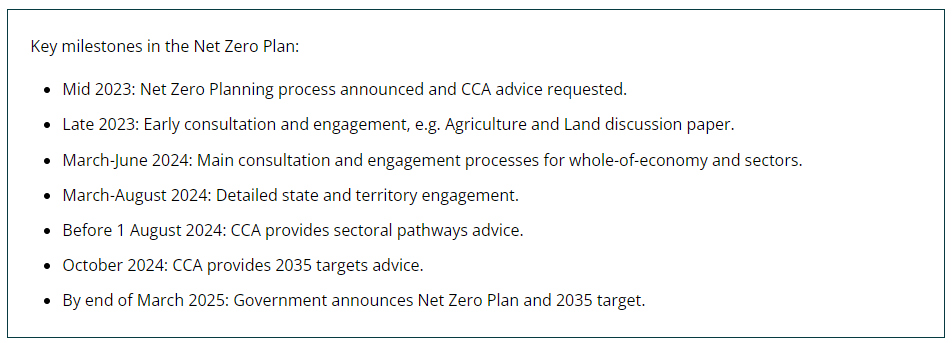Share this article
In recent years, many of Australia’s largest emitters have understandably directed their focus towards 2030. The last federal election had the 2030 Nationally Determined Contribution (NDC) as a key point of focus, while the revised Safeguard Mechanism (SGM) has been revised as the key tool to drive Australia’s 43% 2030 reduction target. 2030 also marks the end of the Renewable Energy Target (RET) designed to encourage the increased use of renewables and reduce emissions.
But in seeking a resilient and sustainable future for business – is planning for 2030 enough?
As 2035 approaches, countries around the globe will update their NDCs in accordance with the Paris Agreement. Early signs are that Australian businesses will face a steep increase in demand for ambitious action.
The federal Government has outlined this is a key milestone “As part of developing the Net Zero Plan, the Australian Government will set Australia’s 2035 targets. This is our next big step on the path to net zero.”

Ambitious 2035 Climate Targets are already emerging
Importantly, we’ve already seen examples of what 2035 might hold for Australia and a sign of what’s to come.
Victoria: Aims to reduce emissions by 75% to 80% below 2005 levels by 2035, and has a renewable energy target of 95% by the same year. “These targets place Victoria alongside international climate leaders and will bring real benefits for Victorians, including new jobs, energy bill savings, improved health and environmental benefits.”
Queensland: Is seeking to reduce emissions by 75% by 2035. “Decarbonising the Queensland economy brings jobs for Queenslanders, reduces cost of living pressures on families, and acts on climate change.”
New South Wales: Has committed to a target of reducing emissions by 70% below 2005 levels by 2035. “Getting to net zero is an important part of the NSW Government’s plan to grow a sustainable low carbon economy, create jobs, reduce the cost of living, and improve environmental outcomes through our emissions reduction initiatives.
The targets are part of broader strategies to transition to renewable energy sources, increase the use of sustainable technology such as electric vehicles, enhance energy efficiency, and reduce reliance on fossil fuels.
The targets reflect a strong and growing commitment across Australian states and territories to address climate change aggressively, aiming for deep cuts in emissions over the next decade. They also demonstrate the risk of continued inaction.
Decisions made now could have serious implications on businesses’ ability to deliver the change necessary for 2035.
To secure a sustainable future, what actions should businesses be taking today?
Emerging signs of growing ambition from Australian states and territories should act as a wake-up call for emissions-intensive businesses.
The need for longer-term, deeper decarbonisation action is growing. But so too is the urgent need for immediate action to secure a sustainable future for business, our societies and the planet.
Today, all companies should be taking climate action seriously.
This means embedding short, medium and long-term sustainability goals into their strategic business planning. It also includes having a good understanding of the organisational carbon footprint (all scopes), having a clear understanding of material Environmental, Social and Governance (ESG) indicators including climate risks to comply with upcoming mandatory climate-related disclosures and setting clear (ideally science-based) targets that take into account governmental ambitions and a credible emissions reduction pathway.
How can businesses prepare for 2035 and beyond?
The strategic decisions companies make today will determine their resilience and competitiveness in a future shaped by evolving regulation and shifting stakeholder demands. That is why the time for long-term planning and climate risk management is now.
Long-term climate thinking should be a top priority for Australia’s largest emitters such as those reporting to the Safeguard Mechanism and NGERs.
So too should it be priority for small to medium organisations who will be disrupted by the coming changes, or those who stand to face growing climate scrutiny under the mandatory climate-related financial disclosures legislation to be implemented in the coming years.
To help guide businesses navigate the road ahead, our experts will be authoring a series focused on the key themes your executives and your business will need to consider in the near future.
We’ll explore topics such as the role and impact of Australia’s proposed Carbon Border Adjustment Mechanism (CBAM), or what Australia’s 2035 NDC could be and how that will shape the business landscape ahead. We’ll also explore the complex yet critical role that carbon offsets will play, what is the cost of inaction and more.
Follow along as we explore and unpack the trends that are just over the horizon, guiding you through the key sustainability challenges ahead and preparing your business to prosper in an increasingly decarbonised world.
Follow us on Linkedin, sign up to our news and reach out to our experts if you’d like to discuss your sustainablity initiatives.


